
The CP Class 0400, commonly called by the nickname Rolls Royce, refers to a type of railcar that was used by the Portuguese Railway Company and its successor, between 1965 and 2001.

The CP Class 0400, commonly called by the nickname Rolls Royce, refers to a type of railcar that was used by the Portuguese Railway Company and its successor, between 1965 and 2001.
They entered service with the operator Portuguese Railway Company in 1965, having been built on the premises of the company Sorefame. [1]
In 1994, the remodelling of the railcars in this series was already being planned in the Porto workshops of the Rail Equipment Maintenance Company, with various changes to the interiors and the replacement of the original engines with more recent ones manufactured by Volvo; it was also planned to build a prototype for the operator Portuguese Railway Company. [2] They were refurbished there between 1994 and 1995 and underwent several changes; inside, the wooden dividers were made of glass and new curtains, seats and side panels were introduced, in different colours to the previous ones. One of the toilets was also removed in order to provide more seating, and the light sources were changed to produce more illumination. In the driving cabs, the colour scheme was also changed, and the seat for the co-driver was removed and a more ergonomic seat for the driver was added. [3]
All the units in this series after being remodelled were integrated into the CP Class 0450 series, becoming extinct in 2001. [1]

A railcar is a self-propelled railway vehicle designed to transport passengers. The term "railcar" is usually used in reference to a train consisting of a single coach, with a driver's cab at one or both ends. Some railway companies, such as the Great Western, termed such vehicles "railmotors".

The Budd Rail Diesel Car (RDC), also known as the Budd car or Buddliner, is a self-propelled diesel multiple unit (DMU) railcar. Between 1949 and 1962, 398 RDCs were built by the Budd Company of Philadelphia, Pennsylvania, United States. The cars were primarily adopted for passenger service in rural areas with low traffic density or in short-haul commuter service, and were less expensive to operate in this context than a traditional diesel locomotive-drawn train with coaches. The cars could be used singly or coupled together in train sets and controlled from the cab of the front unit. The RDC was one of the few DMU trains to achieve commercial success in North America. RDC trains were an early example of self-contained diesel multiple unit trains, an arrangement now in common use by railways all over the world.

Sentinel Waggon Works Ltd was a British company based in Shrewsbury, Shropshire that made steam-powered lorries, railway locomotives, and later, diesel engined lorries, buses and locomotives.

CP — Comboios de Portugal, EPE is a state-owned company which operates passenger trains in Portugal. Prior to June 2009, CP stood for Caminhos de Ferro Portugueses although the company has been using its current designation as a brand name since 2004.
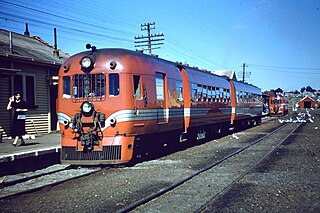
The NZR RM class 88-seaters were a class of railcar used in New Zealand. New Zealand Government Railways (NZR) classified them as RM (Rail Motor), the notation used for all railcars, numbering the 35 sets from RM100 to RM134. They were the most numerous railcars in NZR service. Their purchase and introduction saw the demise of steam-hauled provincial passenger trains and mixed trains, and was part of a deliberate effort to modernise NZR passenger services at a time of increasing competition from private motor vehicles. Being diesel powered and lighter the railcars were less expensive to operate and able to maintain quicker timetables, although became plagued with mechanical and electrical problems, with a number of the class eventually being turned into depowered locomotive-hauled carriages and reclassified as the AC class "Grassgrubs".
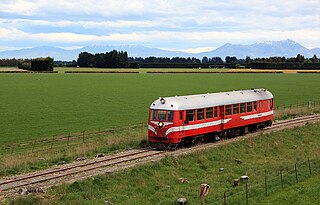
The NZR RM class Vulcan railcars were operated by the New Zealand Government Railways (NZR) in the South Island of New Zealand. All New Zealand railcars are classified as RM (Rail Motor), and this class derived their nomenclature from the name of the manufacturer, the Vulcan Foundry of Britain.
The Taranaki Flyer was the name given to a passenger train that was operated by the New Zealand Railways Department between Whanganui and New Plymouth from 1926 to 1965.

The DRC was a class of railmotor operated by the Victorian Railways on its country rail network in Victoria, Australia. The cars were built by Tulloch Limited in New South Wales, and featured aluminium and steel construction, air-conditioning, and twin diesel engines with hydraulic transmissions.
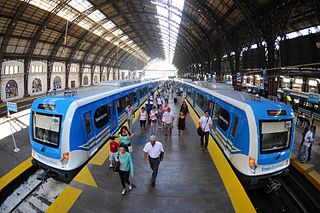
The Mitre line is an Argentine broad gauge commuter rail service in Buenos Aires Province and is part of the Ferrocarril General Bartolomé Mitre division. The service is currently operated by the State-owned company Operadora Ferroviaria Sociedad del Estado after the Government of Argentina rescinded its contract with Corredores Ferroviarios in March 2015.
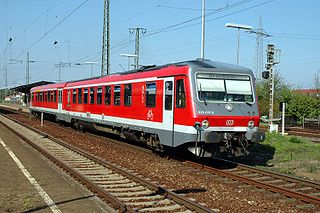
The DB Class 628 is a twin-car, diesel multiple unit operated by the Deutsche Bahn for local passenger rail services.

The Córas Iompair Éireann (CIÉ) 2600 Class were Associated Equipment Company (AEC)–engined diesel multiple units that operated InterCity and suburban services on the CIÉ system between 1952 and 1975. Many were later converted for push–pull operation with diesel locomotives, finally being withdrawn when displaced by the electric Dublin Area Rapid Transit service in the mid-1980s.

The history of rail transport in Portugal dates from 28 October 1856, when Portugal's first railway line was opened between Lisbon and Carregado: the Companhia dos Caminhos de Ferro Portugueses.
Sorefame was a Portuguese manufacturer of railway rolling stock and industrial equipment, such as dam gates equipment. The company was established in 1943.

The Série 0350 are a type of single carriage diesel railcar used by Portuguese Railways (CP). They were built by Allan of Rotterdam in the Netherlands in 1954-55. In 2000 they were extensively modernised and reclassified as Série 0350. The distinctive roof pod above the driver's compartment houses heat dissipators for rheostatic braking.
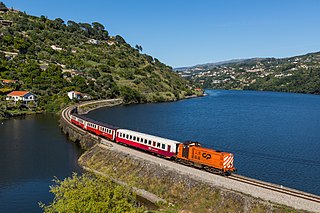
The Douro line is a 99-mile railway line in northern Portugal that runs from Ermesinde to the eastern terminus at Pocinho. The line runs close to the Douro River for much of its route, offering scenic views of the river and valley. Passenger trains are operated by Comboios de Portugal (CP) and run between Porto São Bento and Pocinho, taking 3 hours and 20 minutes. Freight trains operated by Medway also run on the line.

Diesel multiple units and railcars are trains, usually with passenger accommodation, that do not require a locomotive. Railcars can be single cars, while in multiple units cars are marshalled together with a driving position either end. As of December 2010, 23 percent of the rail passenger cars used on Network Rail are part of a diesel multiple unit.

Linha do Algarve is a railway line in the region of Algarve, in southern Portugal, which connects the stations of Lagos to the west and Vila Real de Santo António to the east of the Portuguese region.

Linha da Beira Alta is an international railway line which connects Pampilhosa on the Linha do Norte, close to Coimbra, to the border with Spain, at Vilar Formoso.

Ramal do Pego is a railway branch in Portugal, which connects the station of Mouriscas-A, on the Linha da Beira Baixa, to the Pego Power Station.

Linha de Sintra is a railway line which connects the stations of Rossio and Sintra, Portugal. It is operated by Comboios de Portugal.